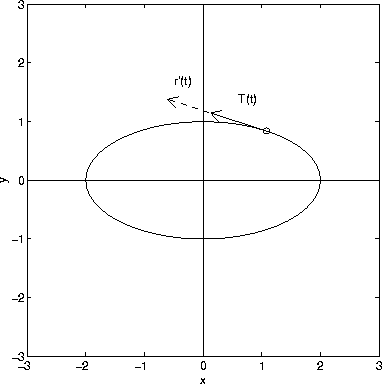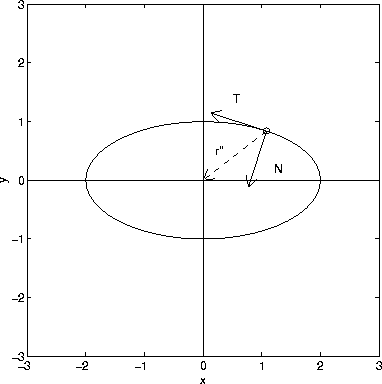Let r(t)=<f(t),g(t),h(t)> be the position vector of a particle. The velocity of the particle is given by
![]()
and the acceleration is given by
![]()
In the following discussion we gain further insight into these formulas.
Velocity
We can write the velocity in terms of the unit tangent vector T(t). Recall that
![]()
The magnitude of the velocity, |r'(t)|, is the speed and is often denoted v(t). It follows that
![]()
Recall that the velocity vector r'(t) is tangent to the space curve r(t). This is shown in the plot below for the position function r=<2cos(t),sin(t)>, where the velocity r'(t)=<-2sin(t),cos(t)> and the unit tangent vector are plotted.

Acceleration
Acceleration is given by the formula
![]()
Here we have used the product rule for differentiation of the product of a scalar function and a vector function. An interesting fact is that T'(t) is orthogonal to T(t)!. We prove this by noting that
![]()
since T(t) is a tangent vector. Taking the derivative of both sides above we have
![]()
We have used the rule for differentiating the dot product of two vector functions. Noting that the order does not matter in the dot product, we have
![]()
Since T(t) is tangent to the space curve r(t). The vector T'(t) is normal to the space curve. In three dimensions, there are an infinite number of linearly independent vectors normal to r(t). The direction represented by T'(t) is called the principal normal direction. The unit vector
![]()
is called the principal unit normal vector.
We can write the acceleration:
![]()
Recalling that |T'(t)|/v(t) is the curvature, we have
![]()
This last formula shows that there are components of acceleration tangential and normal to r(t). These components are
![]()
and
![]()
Example
Let r(t)=<2cos(t),sin(t)>. Find the tangential and normal components of the acceleration.

We have r'(t)=<-2sin(t),cos(t)> and
![]()
Differentiating this last expression, we have:
![]()
From a previous calculation,
![]()
Hence,
![]()
[Vector Calculus Home] [Math 254 Home] [Math 255 Home] [Notation] [References]
Copyright © 1996 Department of Mathematics, Oregon State University
If you have questions or comments, don't hestitate to contact us.